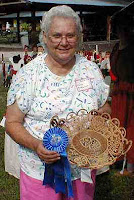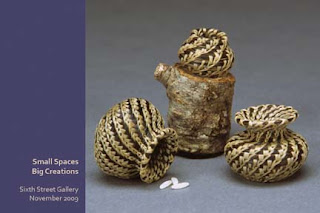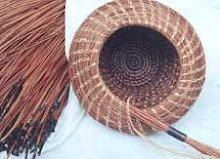Thanks to everyone who has been following along, and especially those who are leaving comments! It is much easier to have a series like this when there is participation from the readers.
The
last post was about binder length. Thanks to Donna, Judy and Tony who told us about their methods. when this series is over, i would like to post my method for adding binder, more specifically, and perhaps it will help you Tony. To Donna, i must ask: how do you assure the knot is completely covered by the coil above? Is this calculated into the placement of the knot? Does this dictate the shaping of your basket? I am very interested in this method, as i have had many people tell me they use it...but i still cannot figure out how it is beneficial. I would love to watch you work sometime!
Now, about collecting and preparing pine needles....I have had many people tell me they spend a lot of time cleaning their pine needles before making a basket with them. Some wash in boiling water, soap or bleach, or all three. Some actually boil them. (One person told me they used PESTICIDE on their needles...which made me gasp...of course pesticide will stay there, and pesticide is poison...is that what you want on your basket, and on your hands as you make it???)I have never really understood this. If needles are removed from a prepared lawn, one without animal droppings, I believe they are as clean as they need to be. The same with a pristine wooded area. What, exactly, are you removing?
I would like to preserve as much of the natural oil in the pine needle as possible. Isn’t pine oil a comment ingredient in cleansers (aka PineSol?) As an organic material, pine fibers are subject to decomposition, but the naturally occurring oils combat premature breakdown, as well as attack by bugs. It is the pine tree's own genetically programmed protection. Don't we want to take advantage of that? Isn't this also where the wonderful smell of pine comes from? Boiling needles and subjecting them to harsh chemicals does nothing to stabilize the delicate fiber of the pine needle, and much to damage it.

I have never found little bugs in pine needles I pick up. I think pine needles are naturally very clean. It is very important, however, to first check for animal droppings, and even to ask the owner of the property: “do you have dogs?” If animals frequent the area, I would simply not collect there.
Freshly dropped needles have a wonderful honey brown color, and generally appear very clean. If needles you have found are spotty or have mildew growing on them, they are probably not fresh, have been laying on the ground for months, and would benefit from cleaning. Some spots on pine needles are the result of illness or disease in the tree, and there is not much you can do about that. If you have no choice but to use these needles, of course this will add to the preparation time of your basket.
I recommend looking for clean needles, as opposed to cleaning them every time. If you use bleach to clean your needles, use diluted bleach. Only a tablespoon for a gallon or two of water is fine. it is important that you then neutralize the bleach by rinsing in vinegar, and then very well in water. Ever heard of "acid free" environments that museum curators try to cultivate? Acid contributes to breakdown of materials...but base (the opposite of acid: alkali) does too. Bleach is a VERY strong base, and eats away at things too. If you don't neutralize the bleach, it continues to work...vinegar neutralizes bleach. If you use only as much vinegar as you did bleach, HOPEFULLY you neutralize it, not make it acid. But i would just as soon avoid messing with the pH of the needles all together.
If you suspect your needles harbor very tiny things you cannot see, like chiggers, alternatives to cleaning with water and bleach may be:
• Laying in the strong sunlight on screens for an extended period (turning regularly, assuring there is air circulating on all side, if possible)
• Freezing for a period of a month or more
Another way to get clean needles is to remove them green. I do not advocate removin

g them from a growing tree, as this could compromise the tree, making it sick or killing it. It takes more than one year for a pine needle to mature.
Sometimes storm-downed trees will render green needles. Lots of people cut trees down. When you see someone cutting down a longleaf pine tree, it pays to ask for a branch or two. Most of the time, they do not care that you want it. They usually don't want any part of the tree, not even the wood, as it i

s not very good for heating with. At right is the ditch bank in front of my house several years ago...the neighbors cutting two longleaf pines were very happy to have it all dumped in front of my house. After Lynn and I harvested all the needles, we had to haul it to the dump! Alot of work, but we had needles for a LONG time!

Needles that have been harvested directly from the tree rarely need cleaning, but will need to dry before use. If you do get green needles, make sure you spread or hang to dry. You notice the bundles above are only secured at the top, so they flare out, to allow for drying. If there is a place you can hang the whole branch, well, you have saved yourself a step...that works, too, but requires much more room.
The
next post is about removing fascicles from pine needles…can you hold those thoughts until then? Thanks! Please comment on this post about collecting and preparing pine needles (except for removal of sheath ends. )
 Not out shopping? Maybe you already have been, but are back home? No need to feel left out!
Not out shopping? Maybe you already have been, but are back home? No need to feel left out!



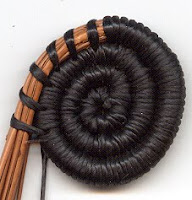
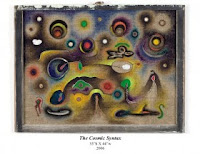


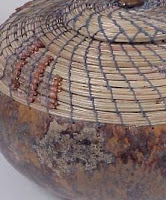

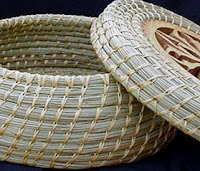
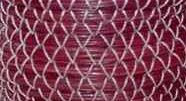 Stitching forward is quicker than constant reversals. So using the fern stitch (2 stitches in each hole, moving forward) is faster than a "V" stitch, which is still 2 stitches in each spot, but requires backstitching a row (two stitches in each hole, one moving forward and one moving backward.) Once you learn all the stitches
Stitching forward is quicker than constant reversals. So using the fern stitch (2 stitches in each hole, moving forward) is faster than a "V" stitch, which is still 2 stitches in each spot, but requires backstitching a row (two stitches in each hole, one moving forward and one moving backward.) Once you learn all the stitches 


